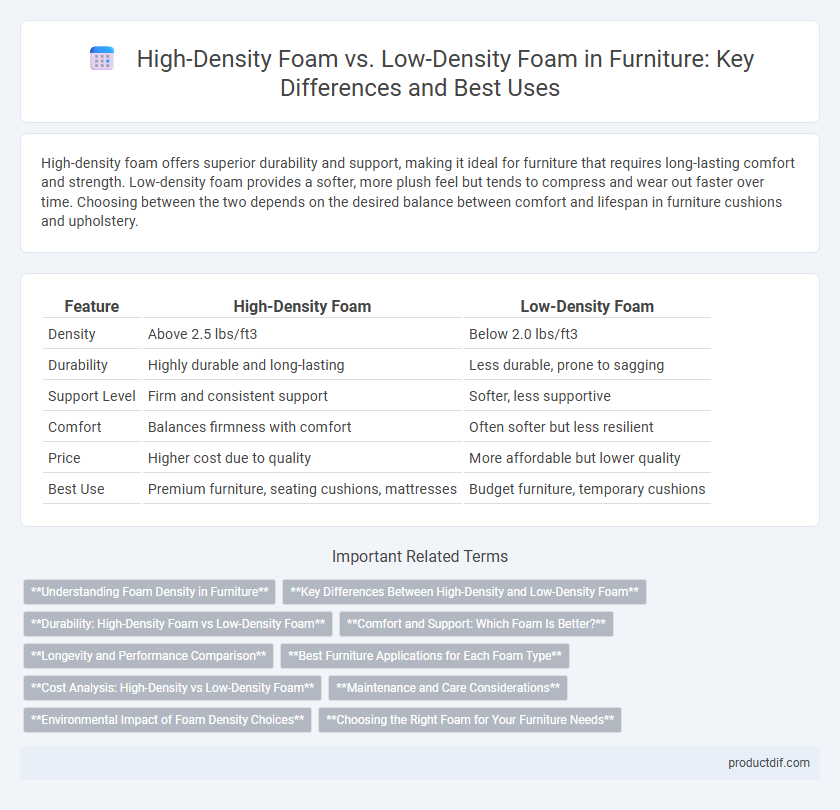High-density foam offers superior durability and support, making it ideal for furniture that requires long-lasting comfort and strength. Low-density foam provides a softer, more plush feel but tends to compress and wear out faster over time. Choosing between the two depends on the desired balance between comfort and lifespan in furniture cushions and upholstery.
Table of Comparison
| Feature | High-Density Foam | Low-Density Foam |
|---|---|---|
| Density | Above 2.5 lbs/ft3 | Below 2.0 lbs/ft3 |
| Durability | Highly durable and long-lasting | Less durable, prone to sagging |
| Support Level | Firm and consistent support | Softer, less supportive |
| Comfort | Balances firmness with comfort | Often softer but less resilient |
| Price | Higher cost due to quality | More affordable but lower quality |
| Best Use | Premium furniture, seating cushions, mattresses | Budget furniture, temporary cushions |
Understanding Foam Density in Furniture
High-density foam in furniture offers superior durability, support, and resilience, making it ideal for frequently used seating and mattresses. Low-density foam provides softer comfort but tends to compress faster and lose shape over time, affecting long-term usability. Understanding foam density helps consumers choose the right balance between comfort and longevity tailored to their furniture needs.
Key Differences Between High-Density and Low-Density Foam
High-density foam, with a density of 2.5 to 3.5 pounds per cubic foot, offers superior durability, support, and resistance to compression compared to low-density foam, which typically ranges from 1.5 to 2.5 pounds per cubic foot. High-density foam maintains its shape and firmness over time, making it ideal for long-lasting furniture cushions, while low-density foam provides a softer, more affordable option but tends to degrade faster. The choice between high-density and low-density foam directly impacts comfort, longevity, and cost-effectiveness in upholstery and mattress applications.
Durability: High-Density Foam vs Low-Density Foam
High-density foam offers superior durability compared to low-density foam, maintaining its shape and firmness over extended use. Its tightly packed cells resist sagging and compression, making it ideal for high-traffic furniture like sofas and office chairs. In contrast, low-density foam tends to break down faster, losing support and comfort within a shorter period.
Comfort and Support: Which Foam Is Better?
High-density foam offers superior support and durability, making it ideal for furniture that requires long-lasting comfort and structural integrity. Low-density foam provides a softer, more cushioned feel but tends to compress quickly, reducing support over time. Choosing between the two depends on prioritizing firmness and support for prolonged use versus initial softness and mild comfort.
Longevity and Performance Comparison
High-density foam in furniture offers superior longevity and maintains its shape and support over extended periods compared to low-density foam, which tends to compress and lose resilience faster. The denser cell structure of high-density foam enhances durability and performance, making it ideal for frequently used seating and mattresses. Low-density foam provides initial comfort but degrades more quickly under regular use, leading to sagging and reduced support.
Best Furniture Applications for Each Foam Type
High-density foam excels in furniture requiring durability and support, making it ideal for sofas, armchairs, and mattresses that endure frequent use. Low-density foam is better suited for furniture pieces where comfort and cushioning are prioritized, such as decorative pillows, casual seating, and lightweight cushions. Selecting the appropriate foam density enhances furniture longevity and user comfort tailored to specific application needs.
Cost Analysis: High-Density vs Low-Density Foam
High-density foam typically costs 20% to 50% more than low-density foam due to its superior durability and longer lifespan, which reduces replacement frequency in furniture applications. Low-density foam offers a budget-friendly option but may require more frequent replacement because of faster degradation in support and comfort. Investing in high-density foam results in better long-term value despite higher upfront costs, as it maintains shape and resilience under regular use.
Maintenance and Care Considerations
High-density foam requires less frequent replacement due to its durability, making it ideal for long-term furniture use. Low-density foam may compress more quickly, necessitating regular fluffing and rotation to maintain shape and comfort. Proper cleaning with mild detergents and avoiding excessive moisture preserves foam integrity and prolongs furniture lifespan.
Environmental Impact of Foam Density Choices
High-density foam, typically made with higher amounts of polyurethane, has a longer lifespan and better durability, reducing the frequency of furniture replacement and minimizing landfill waste. Low-density foam breaks down faster and often contains more volatile organic compounds (VOCs), contributing to indoor air pollution and environmental harm during decomposition. Choosing high-density foam supports sustainable furniture practices by lowering overall environmental impact through extended product use and reduced chemical emissions.
Choosing the Right Foam for Your Furniture Needs
High-density foam offers superior durability and support, making it ideal for furniture that endures frequent use, such as sofas and office chairs. Low-density foam provides softer cushioning and is more cost-effective, suited for decorative cushions and occasional seating. Selecting the right foam depends on balancing comfort preferences with the expected longevity and function of the furniture piece.
High-density foam vs low-density foam Infographic

 productdif.com
productdif.com